| |
Sustained Benefits in Vascular Function Through Flavanol-Containing Cocoa in Medicated Diabetic Patients
|
| |
| |
A Double-Masked, Randomized, Controlled Trial
J Am Coll Cardiol, June 3 2008; 51:2141-2149, doi:10.1016/j.jacc.2008.01.059
".....regular daily intake of flavanol-containing cocoa reverses vascular dysfunction in medicated diabetic patients....A single-dose intake of flavanol-containing cocoa improved endothelial function accompanied by increases in plasma flavanol metabolites.....Interestingly, after a 30-day dietary intervention, the composite maximum increase in FMD (the combination of chronic and acute effects) was 5.8 ± 1.6% on day 30, indicating a reversal of endothelial dysfunction....Our study clearly establishes improvements of endothelial function after regular consumption of flavanol-containing cocoa in patients with type 2 diabetes, highlighting the potential of flavanol-containing diets, and underscoring the potential health care benefit for reducing the risk of cardiovascular events in diabetic patients.....In the context of human nutrition, flavanols are found in fruit, vegetables, tea, red wine (6), and especially high concentrations can be present in cocoa and cocoa products (7). Dietary interventions with flavanol-containing cocoa products in humans indicate beneficial effects of flavanols on low-density lipoprotein oxidation (8), platelet aggregation (9), insulin sensitivity (10), endothelial function (11), and blood pressure (12)."
Jan Balzer, MD*, Tienush Rassaf, MD*, Christian Heiss, MD*, Petra Kleinbongard, PhD*, Thomas Lauer, MD*, Marc Merx, MD*, Nicole Heussen, PhD{dagger}, Heidrun B. Gross, PhD{ddagger}, Carl L. Keen, PhD{ddagger}, Hagen Schroeter, PhD and Malte Kelm, MD*,*
* Department for Cardiology, Pulmonology, and Vascular Medicine, University Hospital RWTH Aachen, Aachen, Germany
{dagger} Department of Medical Statistics, University Hospital RWTH Aachen, Aachen, Germany
{ddagger} Department of Nutrition, University of California, Davis, California
Mars Symbioscience, Rockville, Maryland.
Abstract
Objectives: Our goal was to test feasibility and efficacy of a dietary intervention based on daily intake of flavanol-containing cocoa for improving vascular function of medicated diabetic patients.
Background: Even in fully medicated diabetic patients, overall prognosis is unfavorable due to deteriorated cardiovascular function. Based on epidemiological data, diets rich in flavanols are associated with a reduced cardiovascular risk.
Methods: In a feasibility study with 10 diabetic patients, we assessed vascular function as flow-mediated dilation (FMD) of the brachial artery, plasma levels of flavanol metabolites, and tolerability after an acute, single-dose ingestion of cocoa, containing increasing concentrations of flavanols (75, 371, and 963 mg). In a subsequent efficacy study, changes in vascular function in 41 medicated diabetic patients were assessed after a 30-day, thrice-daily dietary intervention with either flavanol-rich cocoa (321 mg flavanols per dose) or a nutrient-matched control (25 mg flavanols per dose). Both studies were undertaken in a randomized, double-masked fashion. Primary and secondary outcome measures included changes in FMD and plasma flavanol metabolites, respectively.
Results: A single ingestion of flavanol-containing cocoa was dose-dependently associated with significant acute increases in circulating flavanols and FMD (at 2 h: from 3.7 ± 0.2% to 5.5 ± 0.4%, p < 0.001). A 30-day, thrice-daily consumption of flavanol-containing cocoa increased baseline FMD by 30% (p < 0.0001), while acute increases of FMD upon ingestion of flavanol-containing cocoa continued to be manifest throughout the study. Treatment was well tolerated without evidence of tachyphylaxia. Endothelium-independent responses, blood pressure, heart rate, and glycemic control were unaffected.
Conclusions: Diets rich in flavanols reverse vascular dysfunction in diabetes, highlighting therapeutic potentials in cardiovascular disease.
Abbreviations and Acronyms
FMD = flow-mediated dilation
GTN = glycerol trinitrate
NO = nitric oxide
Diet is a major lifestyle factor that can greatly influence the incidence and the progression of chronic diseases, such as cancer, cardiovascular disease, and diabetes (1). Recently, flavanols, a subgroup of plant-derived phytochemicals called flavonoids, have gained increasing attention, as epidemiological investigations revealed an inverse correlation between the dietary intake of flavanols and the mortality of cardiovascular disease (4), and the incidence of diabetes (5). In the context of human nutrition, flavanols are found in fruit, vegetables, tea, red wine (6), and especially high concentrations can be present in cocoa and cocoa products (7). Dietary interventions with flavanol-containing cocoa products in humans indicate beneficial effects of flavanols on low-density lipoprotein oxidation (8), platelet aggregation (9), insulin sensitivity (10), endothelial function (11), and blood pressure (12).
Controlled trials evaluating longer-term effects of flavanol-containing cocoas on endothelial function in diabetic patients are missing. The aim of this double-masked, randomized, controlled study was to examine the vasculoprotective impact of daily flavanol-containing cocoa intake in diabetic patients.
Discussion
Major findings. The major findings of this randomized trial are: 1) flavanols present in cocoa are absorbed in a dose-dependent fashion in diabetic patients; 2) regular daily intake of flavanol-containing cocoa reverses vascular dysfunction in medicated diabetic patients; 3) vasodilation upon GTN is unaffected by flavanol consumption, indicating the involvement of endothelium-dependent processes; and 4) intake of flavanol-containing cocoa was well tolerated without influencing metabolic profile or hemodynamic parameters.
Acute effects of flavanols in diabetic patients. Diabetic subjects may exhibit alterations of flavanol absorption due to diabetic autonomic neuropathy in different segments of the gastrointestinal tract, such as esophagus and stomach dysmotility, delayed transit, and bacterial overgrowth (17). We observed the absorption of flavanols in diabetic patients, accompanied by increases in plasma flavanol metabolites, leading to a dose-dependent improvement of endothelial function, corroborating our findings from previous studies in nondiabetic populations (14,15). A single-dose intake of flavanol-containing cocoa improved endothelial function accompanied by increases in plasma flavanol metabolites.
Sustained effects of flavanol intake in diabetic patients. Thus far, other investigations have not examined the effects of flavanol-containing cocoa on endothelial function in a diabetic population using materials standardized with regard to their flavanol content, and fully matched regarding their content of macro-nutrients, and micro-nutrients, caffeine, theobromine, and caloric load. In this trial, baseline FMD values, as assessed in a medicated diabetic patient population, indicate that endothelial function is severely impaired. In our laboratory, reference values for FMD are 5.2 ± 0.5% in an age-matched, nonsmoking control group without coronary artery disease, hypertension, diabetes, or hypercholesterolemia (18). Interestingly, after a 30-day dietary intervention, the composite maximum increase in FMD (the combination of chronic and acute effects) was 5.8 ± 1.6% on day 30, indicating a reversal of endothelial dysfunction. Most notably, the degree of reversion of endothelial dysfunction was comparable to the reported degree of FMD improvement observed after intermediate- or long-term interventions in diabetic patients using controlled exercise (19), or the administration of statins inhibitors (20), angiotensin-converting enzyme inhibitors (21), pioglitazone (22), and insulin (23). Assuming that improvement of endothelial dysfunction is associated with a better cardiovascular prognosis (24), the regular intake of flavanol-containing cocoa should produce similar effects.
Potential mechanisms. It is important to comment on the daily amounts of flavanols that may need to be ingested to observe the positive vascular effect obtained in the current report. In an early epidemiologic study by Hertog et al. (4), it was inferred that the daily intake of 30 mg of flavonoids was sufficient to confer considerable vascular protection. However, these estimates were based on an analysis of a limited number of foods. More recently, Mink et al. (25) have estimated that in the U.S. daily intakes of flavanols are on the order of 20 to 100 mg, respectively (25); thus, the amounts of flavonoids used in this study significantly augment the typical diet.
Mechanisms contributing to the biological effects of flavanols include the modulation of cell signalling pathways and gene expression (26), inflammation (27), platelet aggregation (9), and nitric oxide (NO) homeostasis (28). The precise molecular mechanism by which flavanols improve endothelial function in diabetic patients was not determined in this study. However, our findings do provide some insights. Endothelial function as measured by FMD is commonly used as a clinical readout of endothelial NO synthesis. Flow-mediated dilation of the brachial artery is almost entirely NO synthase-dependent (29), correlates with endothelial function of most conduit arteries, and can, therefore, be used as a surrogate for systemic NO synthesis. An increased NO synthase activity in endothelial cells after treatment with red wine polyphenols has been demonstrated in vitro (28). In diabetic subjects, recurrent and prolonged hyperglycemia reduces NO bioavailability, attenuating endothelium-dependent vasodilation and leading to severe endothelial dysfunction (30). The consumption of flavanol-containing cocoa increased peripheral vasodilation in healthy subjects, and the administration of L-NG-monomethyl arginine, a competitive NO synthase inhibitor, significantly diminished the increase in blood flow, suggesting NO-dependent effects (31). We could demonstrate similar results in a former study involving smokers (14). This concept is further supported by the findings presented here, demonstrating that there was no improvement in endothelium-independent vasodilation after administration of GTN, and indicating endothelium-dependent increases of NO bioavailability. The acute benefits of consuming flavanol-containing cocoa on FMD were in the same range at study entry, after 8 days, and after 30 days, ruling out desensitization and tachyphylaxia.
Clinical implications. Impaired endothelial function is a key factor for the development of atherosclerosis and its complications in diabetic patients, and has been shown to be an independent predictor of cardiovascular outcomes in subjects with cardiovascular risk factors or established cardiovascular disease (32). Our study clearly establishes improvements of endothelial function after regular consumption of flavanol-containing cocoa in patients with type 2 diabetes, highlighting the potential of flavanol-containing diets, and underscoring the potential health care benefit for reducing the risk of cardiovascular events in diabetic patients.
Methods
A feasibility study was performed as proof-of-concept and dose-finding, and to assess safety and tolerability. In addition, the effect size of flow-mediated dilation (FMD) was measured in order to calculate appropriate sample sizes for subsequent investigations. In a consecutive efficacy study, the effects of daily flavanol-containing cocoa intake on vascular function were investigated. Both studies were double-masked, randomized, and controlled for macro- and micro-nutrient content in the flavanol-containing cocoa and its control.
Participants. Volunteers of both genders, between 50 and 80 years of age, with established and stably-treated type 2 diabetes mellitus for at least 5 years were screened. Eligibility was confirmed according to the guidelines of the American Diabetes Association (13). Other cardiovascular risk factors and pre-existing cardiovascular disease did not preclude from participation in the study. Exclusion criteria were congestive heart failure with a cardiac ejection fraction of <30%, malignancies, chronic kidney disease with a glomerular filtration rate of <30 ml/min, severe cardiac arrhythmias, and inflammation (C-reactive protein >5 mg/l). All volunteers were either life-long nonsmokers or reported smoking abstinence of at least 5 years before study inclusion. Volunteers participating in the feasibility study were asked to refrain from foods already known to have a high content of flavanols, such as tea, red wine, certain vegetables, and cocoa products (6). Participants enrolled for the efficacy study were allowed to continue their normal, daily lifestyle and eating habits. All volunteers fasted overnight and refrained from their prescribed medication for 12 h before and until completion of the studies in the morning on each study day.
Study design. For the feasibility study, diabetic patients were randomized in a double-masked, 3-period cross-over design, and consumed either a cocoa drink that provided a control (75 mg of flavanols), medium (371 mg of flavanols), or high (963 mg of flavanols) dose of flavanols on 3 different occasions. Eligible patients were assigned to the control, medium, and high flavanol dose by permuted block randomization with blocks of length 3 stratified by gender. The efficacy study was undertaken using a randomized, double-masked, parallel-group design, and eligible diabetic patients were allocated to a treatment group (321 mg of flavanols per dose; 3 doses per day), or a control group (25 mg of flavanols per dose; 3 doses per day). Each group ingested a single dose of either treatment or control thrice daily over a period of 30 days. Volunteers were assigned to the control or the treatment group using permuted block randomization with blocks of lengths 4 stratified by gender. To conceal allocations from investigators, instructed staff at an independent site, not involved in this investigation, generated and maintained the randomization lists.
Study protocols were approved by the institutional review boards. All volunteers were informed about the study, and gave written informed consent to be included. Before intake of the flavanol-containing cocoa, baseline measurements of FMD of the brachial artery, plasma flavanol metabolites, arterial blood pressure, and heart rate were obtained. For the feasibility study, FMD measurements were repeated at 1, 2, 3, 4, and 6 h after ingestion of the cocoa drink (Fig. 1A). Based on previous reports demonstrating that flavanol metabolites reach a maximum plasma level around 2 h after ingestion (14,15), a blood sample was also taken at the 2 h time point to determine plasma flavanol concentrations. Study days were separated by at least 3 days to avoid potential carry-over effects. For the efficacy study, measurements of baseline FMD, blood pressure, heart rate, clinical routine, and plasma flavanol metabolites were obtained on day 0 before intake of the first cocoa drink. To assess acute effects, the latter measurements were repeated on the same day, 2 h after ingestion of the control (25 mg of flavanols) or the treatment (321 mg of flavanols) cocoa drink. Volunteers were then asked to ingest the cocoa drinks thrice daily. For the evaluation of long-term effects, the same study protocol was repeatedly applied on days 8 and 30 (Fig. 1B). Adherence to the study protocol was confirmed by weekly telephone inquiries, and by collecting the returned empty cocoa sachets at each follow-up visit.
Flavanol-containing test materials. The cocoa drinks were supplied as dry cocoa beverage mix by Mars Incorporated (Hackettstown, New Jersey). The flavanol-containing cocoa drinks were made using CocoaPro cocoa powder. All cocoa drinks were standardized for their flavanol content and profile, and closely matched for equal macro-nutrients, micro-nutrients, caloric load, theobromine, and caffeine content (Table 1). All cocoa drinks were similar in taste and supplied in individual, opaque sachets that were labeled with an anonymized 3-digit identifier code. All sachets contained 18 g of cocoa beverage mix, of which 54% (w/w) consisted of nonfat milk powder. A sachet either contained 25 mg (control) or 321 mg of total flavanols. Total flavanol amounts referenced here are defined as the sum of all monomeric flavanols and their oligomeric derivatives (dimers to decamers, i.e., 2 to 10 monomeric subunits). The monomeric flavanol fraction, 18% (w/w) of which is (-)epicatechin, represents approximately 23% (w/w) of the total flavanol content. For the feasibility study, cocoa drinks were prepared by mixing the cocoa beverage powder from 3 cocoa drink sachets into 250 ml of distilled water. The resulting cocoa drinks contained either 75 mg (3 x 25 mg), 371 mg (1 x 321 mg, 2 x 25 mg), or 963 mg (3 x 321 mg) of flavanols. For the efficacy study, participants were asked to mix the content of 1 cocoa sachet in 250 ml of water thrice daily, and to drink it along with their usual meals.
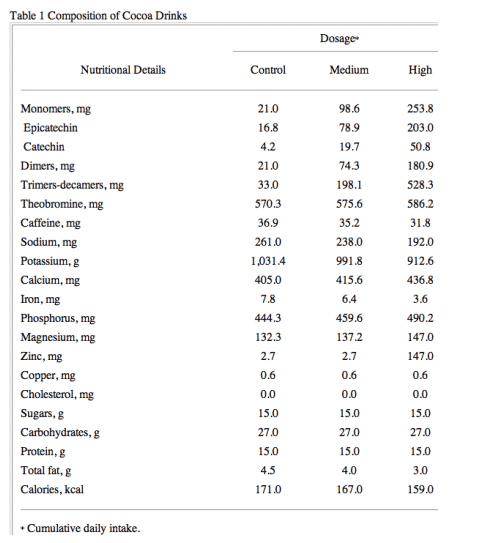
Outcome measures. The primary outcome measure was change of endothelial function, measured as FMD of the brachial artery, using standard techniques according to the guidelines of the American College of Cardiology (16). Briefly, the diameter of the brachial artery was measured 1 to 2 cm above the cubital fossa before and after ischemia of the forearm using a 15 MHz transducer (Vivid 7, GE Healthcare) and an automatic edge-detection software (Brachial Analyzer, Medical Imaging Applications, Iowa City, Iowa) yielding a coefficient of variation of <5%. Reactive hyperemia was induced by 5 min of distal lower arm occlusion. After 60 to 90 s, the diameter was assessed and FMD calculated as relative diameter gain compared with that at baseline. Endothelium-independent dilation was measured 4 min after sublingual application of 400 ��g glycerol trinitrate (GTN). Measurements were performed in the morning after an overnight fasting period in a noise-protected room of constant temperature (24��C).
Secondary outcome measures included changes of the concentration of plasma flavanol metabolites at 2 h after ingestion of cocoa drinks. Free, aglyconic flavanols (epicatechin, catechin), and their respective conjugated flavanol metabolites (3'-O-methyl-epicatechin, 4'-O-methyl-epicatechin, 3'-O-methyl-catechin, 4'-O-methyl-catechin, epicatechin-5/7-O-_-D-glucuronide, 3'-O-methyl-epicatechin-5/7-O-_-D-glucuronide, 4'-O-methyl-epicatechin-5/7-O-_-D-glucuronide) were extracted from plasma and analyzed by high-pressure liquid chromatography using an fluorescence detector detection system (Hewlett Packard 1100 Series; high-pressure liquid chromatography column: Phenomenex Luna C18(2) 150 x 4.6 mm, 3 ��m) under utilization of chemically authentic standards as detailed elsewhere (15). Other pre-specified outcome measures were changes in blood pressure, plasma levels of lipids, fasting plasma glucose, and glycated hemoglobin. Blood samples were analyzed in a central laboratory.
Statistical analyses. Continuous variables are presented as mean ± standard deviation. Categorical data are presented by frequencies and percentages. A repeated measures analysis of variance was applied to compare mean FMD values between patient groups. Model assumptions were checked via Mauchly's test of sphericity. If the within-subject factors failed to meet the assumption of sphericity, we adjusted the results by Huynh-Feldt correction factor. Additionally post-hoc pairwise t tests of baseline values between day 0, 8, and 30 in each group, between the control and treatment groups on each day, and between 0 h and 2 h on each day in the treatment group were performed. Because of the exploratory nature of the analyses, no adjustment was made to account for multiple testing. Sample-size calculations, based on the feasibility study indicated that 20 patients in each group needed to be enrolled to detect an effect size of 0.9 with a 5% 2-sided significance and 80% power. Demographic, anthropometric, hemodynamic, and clinical chemistry parameters were compared with the unpaired t test in case of continuous data; in the case of categorical data, the Fisher exact test was performed. Applied tests were 2-sided, and resulting p values less than an alpha level of 0.05 were considered to indicate statistical significance. Statistical analyses were performed using SAS Release 9.1.3 (SAS Institute Inc., Cary, North Carolina).
Results
Study population. Information on volunteer enrollment, randomization, inclusion and exclusion, as well as reasons for the latter are detailed in Figure 2.
Baseline characteristics. The clinical baseline characteristics of both the study populations assigned to the feasibility study and the efficacy study are shown in Table 2. At the beginning of the efficacy study, demographic and anthropometric parameters were similar in the control and the treatment groups.
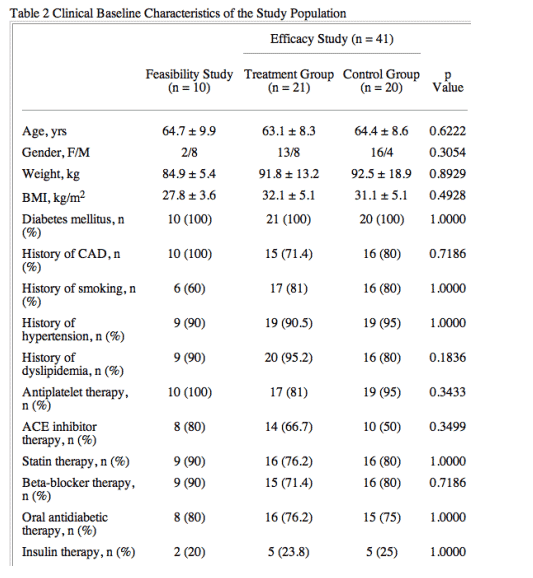
Primary outcome measure. Before intervention, the mean FMD for the feasibility study population was 3.8 ± 0.3%. The consumption of flavanol-containing cocoa dose-dependently increased FMD as shown in Figure 3. Ingestion of the control drink, containing 75 mg of flavanols, did not cause an increase in FMD. When ingesting the highest flavanol dose (963 mg), the average FMD response increased to 5.5 ± 0.4% (p < 0.001) at 2 h after ingestion. On an individual basis, all participants exhibited statistically significant increases in FMD and plasma flavanol concentrations (Fig. 4). Flow-mediated dilation responses returned almost to baseline values at 6 h after cocoa ingestion. The half-life period of biological effects as measured by FMD was reached at around 4 h after consumption of the cocoa drinks containing 371 or 963 mg of flavanols, respectively. Endothelium-independent vasodilation after sublingual application of GTN was similar between study days, and the different dietary interventions (75 mg: 8.4 ± 0.4%; 371 mg: 8.3 ± 0.4%; 963 mg: 8.1 ± 0.3%; p = NS).
Figure 3 Time Course of Acute Changes in FMD Upon Ingestion of Flavanol-Containing Cocoa
For a detailed protocol of the feasibility study, refer to Figure 1A. Baseline values (black) for flow-mediated dilation (FMD) were similar in all groups at study entry. After ingestion of the cocoa drinks, containing either a medium (371 mg; red triangles) or a high (963 mg; red squares) dose of flavanols, FMD increased significantly, while the ingestion of the control drink (75 mg of flavanols; red circles) had no effect. Data are given as mean ± standard deviation. *Indicates significant differences in FMD compared with that seen in baseline within each group, p < 0.05; #Indicates significant differences in FMD between the control and the high-flavanol dose, p < 0.05.
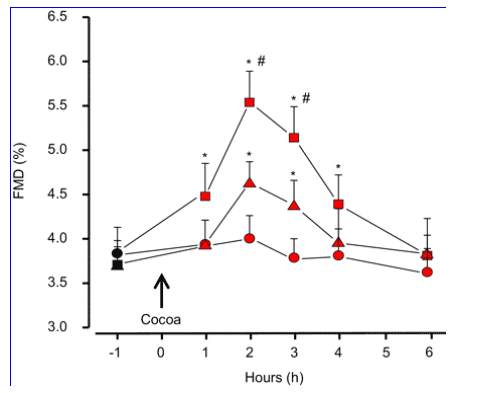
Figure 4 Total Plasma Flavanol Metabolites and FMD
Two hours after the consumption of a cocoa drink containing 963 mg of flavanols at study entry (black squares), every study participant exhibited an increase in flow-mediated dilation (FMD) and in plasma flavanol metabolites levels, demonstrating acute effects (red squares), and supporting the conjecture that a daily intake of a cumulative dose of 963 mg of flavanols may be sufficient to induce a sustained improvement in vascular function over time.
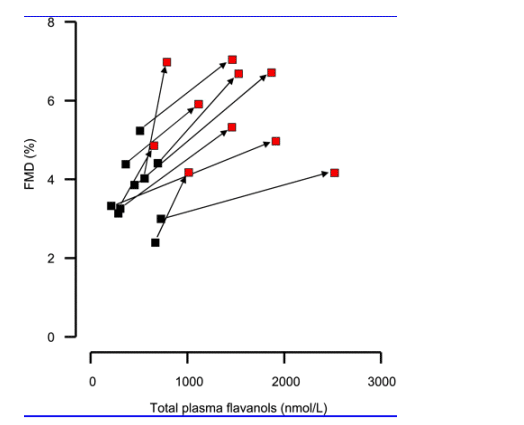
Regarding the efficacy study, baseline FMD values (baseline: t = 0, after overnight fast, before cocoa consumption) at the start of the intervention (day 0) were not statistically different when comparing the control with the treatment group (3.3 ± 1.2% vs. 3.3 ± 1.1%, p = NS). The daily consumption of flavanol-containing cocoa by patients assigned to the treatment group resulted in continual baseline FMD increases. Baseline FMD increased from 3.3 ± 1.1% on day 0 to 4.1 ± 1.1% (p < 0.001) on day 8, and to 4.3 ± 1.2% (p < 0.0001) on day 30. The acute effects on FMD (t = 2 h after cocoa ingestion) in the treatment group were of similar effect size at study entry (3.3 ± 1.1% to 4.8 ± 1.4%, p < 0.0001), after 8 (4.1 ± 1.1% to 5.7 ± 1.6%, p < 0.0001), and 30 days (4.3 ± 1.2% to 5.8 ± 1.6%, p < 0.0001) of regular cocoa intake. These findings indicate that desensitization and tachyphylaxia did not occur. While a composite maximum increase in FMD, established by a combination of chronic and "acute-on-chronic" effects, was highest at day 30 of the investigation, an ablation of the effect size of the composite maximum FMD increase may have already taken place onwards of study day 8 (Fig. 5). No statistically significant changes over time, and in between treatment (8.5 ± 2.3% to 9.1 ± 2.9%, p = NS) and control groups (8.2 ± 2.2% to 7.9 ± 2.4%, p = NS) were observed considering endothelium-independent effects, as assessed after sublingual administration of GTN.
Secondary outcome measures. In the feasibility study, dose-dependent increases in FMD after ingestion of the medium and the high flavanol dose were accompanied by increases in plasma flavanol metabolite levels. The sum of aglyconic flavanols and their respective conjugated flavanol metabolites in plasma increased dose-dependently within 2 h from 509 ± 69 nmol/l to 1,038 ± 95 nmol/l when ingesting 371 mg of flavanols (p < 0.05), and from 463 ± 53 nmol/l to 1,427 ± 80 nmol/l when a 963-mg flavanol dose was given (p < 0.01). The consumption of the control cocoa drink (75 mg of flavanols) did not result in a statistically significant increase in flavanol plasma levels (472 ± 54 nmol/l to 666 ± 72 nmol/l, p = NS).
Regarding the efficacy study, fasting plasma levels of flavanol metabolites in this diet-unrestricted population increased from 1,473 ± 671 nmol/l on day 0 before regular intake of flavanol-rich cocoa to values of 2,152 ± 1,222 nmol/l on day 8 (p < 0.01) and 2,178 ± 995 nmol/l on day 30 (p < 0.01). No significant changes in plasma flavanol metabolites were observed in the control group (day 0: 1,485 ± 1,062 nmol/l; day 8: 1,287 ± 846 nmol/l; day 30: 1,501 ± 1,299 nmol/l, p = NS).
For detailed analysis of laboratory, anthropometric, and hemodynamic parameters please refer to Table 3. Serum values of electrolytes (sodium, potassium, calcium, chloride, phosphate, iron, magnesium, zinc) did not change throughout the entire study. No side effects such as headaches, dizziness, skin exanthems, altered bowel habits, bloating, nausea, vomiting, diarrhea, or cardiac adverse events, such as worsening of Canadian Cardiovascular Society or New York Heart Association functional class, myocardial infarction, need for percutaneous coronary intervention and bypass surgery were observed during the entire duration of the trial.
LDL significantly decreased from 106 to 100 in the treatment group but increased from 103 to 107 in the control group over 30 days of study. Triglycerides insignificantly declined from 151 to 145 in the treatment group but insignificantly increased from 148 to 162 in the control group (p=.0629). Glucose insignificantly increased from 148 to 153 in the treatment group but was 146 at baseline in the control group and 144 after 30 days. HbA1c significantly decreased in both the treatment and control groups.
Table 3 Patient Characteristics of Treatment and Control Groups in the Efficacy Study at Study Entry and at the End of the Study
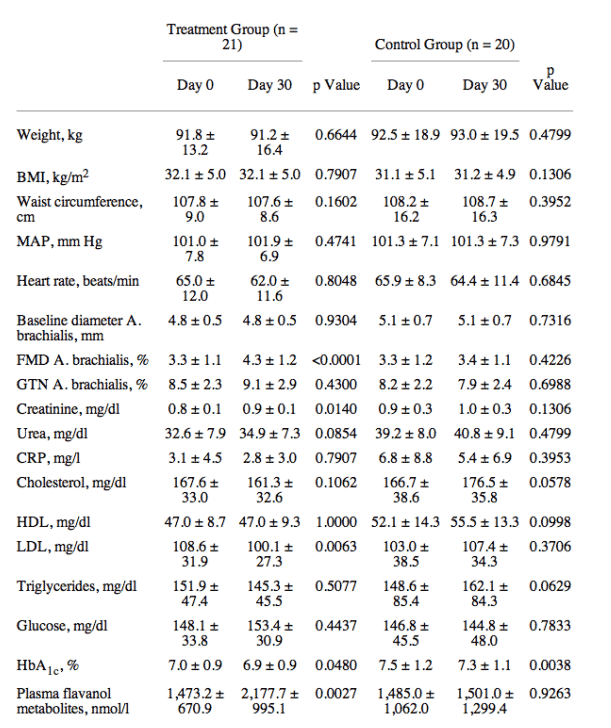
|
|
| |
| |
|
|
|